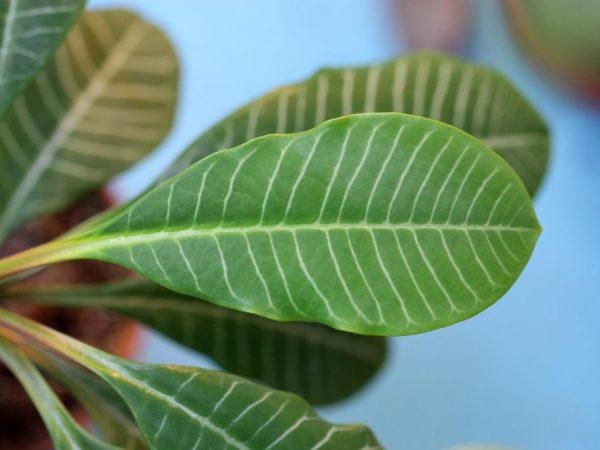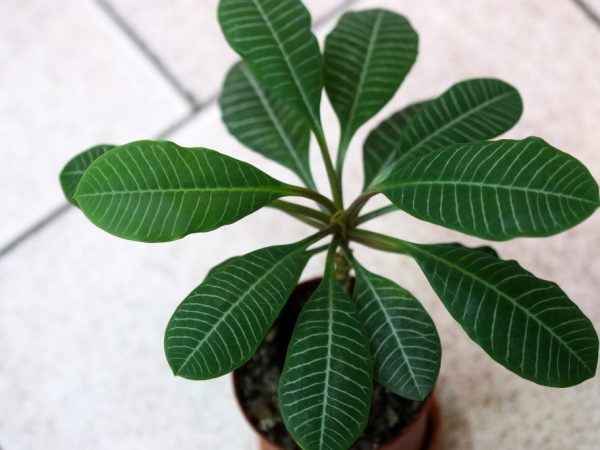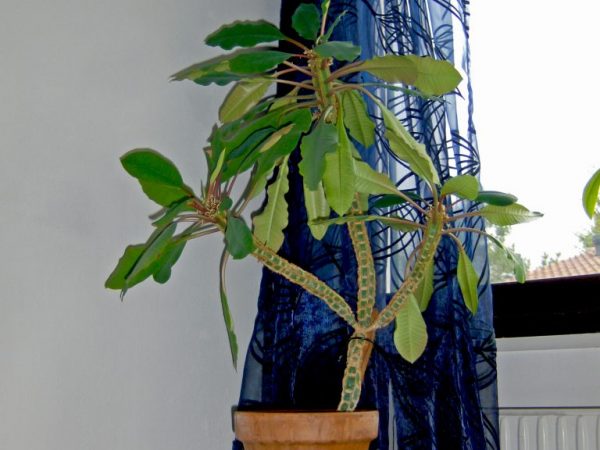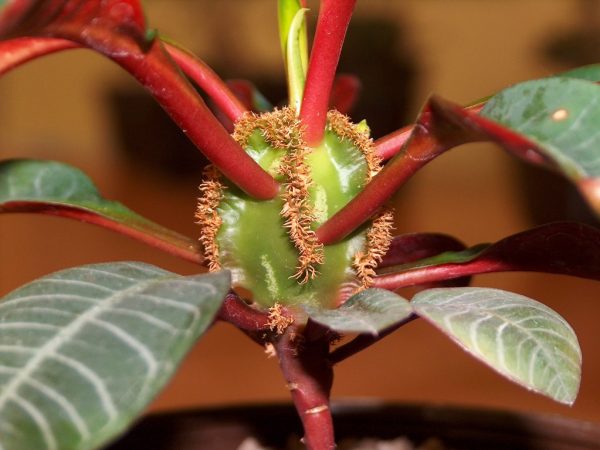Euphorbia white-tipped - a poisonous palm tree or an exotic handsome man?
Euphorbia leuconeura (lat. Euphorbia leuconeura) is a pearl of the subtropics, which is scientifically called euphorbia, and among the people - “monkey palm” or simply “palm”, and sometimes “cactus”. The homeland of the plant is Madagascar.

Euphorbia white-veined
Botanical characteristic
The Latin name of the genus was given in honor of the doctor Euphorba. The historical record states that the doctor served at the court of the Numidian ruler Yubu II in the first century AD. and he cured many diseases with this plant.
In nature, whole forests of euphorbia grow, but not so long ago the flower became an adornment of the interior and greenhouses all over the world. Today it can be found in almost every home or apartment.
Euphorbia white-veined is so named for the leaves with noticeable white-silver veins. With age, the latter darken and the flower becomes not so "sinewy". The petioles remain brownish. As the stem grows, the lower leaves fall off, leaving peculiar scars. When an incision is made, a whitish sap is released from the leaf blades.
The species belongs to stem succulents, despite the decorative crown on the crown, which suggests tropical trees.
This exotic houseplant will decorate any corner, because it grows quite large - at home it reaches 1-1.5 m.
The trunk is round, fleshy, woody from below with age. Small brown spines are located on the ribs. At the top there is a rosette of green oval large leaves up to 15 cm long.
In the future, young leaves grow gradually at the top. Branching only begins in adulthood. This perennial plant does not lose its attractiveness for 10-15 years. Blooming is rather inconspicuous - with small light flowers.
The smell of nectar is not perceptible for a person, but insects will quickly flock to the palm tree in the open air.
Purchase and adaptation
Before purchasing, the plant should be inspected for damage, strange stains, or plaque that could indicate disease. You do not need to take a copy, the leaves of which are crumbling or yellowed.
After the purchase, the flower must be transplanted, because the store substrate is not suitable for permanent maintenance at home.
Euphorbia quickly adapts to the new microclimate, however, it is important to be quarantined for two weeks after purchase and to keep it separate to avoid inadvertently contaminating other plants at home.
Landing
You need to plant a flower in a pot of the appropriate size, wide, but not too deep and large, with a layer of expanded clay at the bottom. A small capacity can provoke the development of lateral shoots, due to which the euphorbia will lose its decorative effect.
It is desirable to place the bush in the substrate deeper, with laying large stones under the drainage to give the plant stability. After planting, the flower is watered with water and fertilizers.
The necessary conditions
Selection of soil and location
Indoor flower is preferable to grow on the southwestern, southeastern, southern windowsills. This herb looks good in compositions with cacti. It feels good next to radiators and other heating devices.
Remember! Spurge is poisonous, so it is better to place it away from children and animals.
The soil should have excellent air permeability and neutral acidity. You can purchase a special substrate for succulents or prepare it by combining brick chips, calcined sand and small pebbles, turf and peat soil in equal parts.
Humidity

The flower does not need to be sprayed
Euphorbia tolerates dry air well, but cultivation is optimal at 40-50% humidity. High humidity can negatively affect the condition of the plant, so it is recommended to brush dust off the leaves with a dry cloth or brush.
Temperature
It is recommended to keep the indoor "palm" at 15-25⁰С. In the summer, you can take the flowerpot out into the fresh air. It is necessary to protect the euphorbia from hypothermia. Insignificant differences will not affect the condition of the flower, but drafts must be avoided.
Euphorbia blooms after a dormant period, which begins when the temperature drops to 12-14⁰С. At this time, buds are laid. The best months for "wintering" are from October to February.
Lighting
This succulent is photophilous and can withstand even the direct action of sunlight, but in the summer, the rays can provoke burns, so at noon it is advisable to shade the green pet from the scorching sun.
It is better to put the flowerpot in a secluded corner with good diffused lighting, and in winter you will have to organize supplementary lighting with phytolamps, otherwise the leaves will fade and the growth of the tree will slow down.
Home care
Fertilizers and feeding
Propagation by cuttings and seeds, flowering, active growth require additional strength from the plant.
During warmer months, it is recommended to add cactus additives once a month when watering. Fertilizers are not used in autumn and winter.
During the flowering period, potash dressings are used.
Watering
Watering is carried out according to the following regime:
- in the summer - 2-3 times a week;
- in winter - once every 20 days - a month;
- at temperatures below 12⁰С, watering is not performed.
Euphorbia is a succulent, therefore waterlogging can lead to decay - all moisture is already stored in the stem. But drying out also cannot be allowed.
If the soil is excessively dry, then water is added gradually.
The water should not be cold, preferably at room temperature or warm. It is better to drain the excess liquid from the pallet.
Transfer
The transplant is carried out with the onset of the warm season. For young specimens - annually, for mature ones - once every 2 years or as the root system grows.
Before starting the procedure, the flower is watered. When removing a plant from an old pot, you do not need to forcefully clean the soil from the roots - let the excess crumble by itself.
A transplant is necessary in the following cases:
- after purchase in a store;
- with overgrowth or decay of roots;
- if the soil is infected with parasites.
Pruning

Pruning stimulates the growth of side shoots
It is not necessary to prune the spurge. Formative pruning is performed in the following cases:
- if it is necessary to shorten deformed shoots and too high a bush;
- to make the flower more magnificent;
- to stimulate branching.
To do this, the top is trimmed with a sharp knife in spring or summer with a frequency of once every couple of years. The knife should be wiped with alcohol in advance. The released juice is washed off with warm water, and the place of the cut is sprinkled with coal.
Reproduction methods
It is quite easy to grow new specimens both from seeds and by propagation by cuttings.
Seeds
Propagation is easy in this way - after flowering, "boxes" with the appropriate content are formed.
Note! Euphorbia shoots seeds - this is how self-sowing occurs in nature. To avoid losing the seeds, wrap the pods with a cloth beforehand or simply scoop out the seedlings from the mother's pot.
Sowing is carried out in moistened soil after preliminary soaking. The container is covered with foil. Further, periodic spraying and airing of the seedlings is required.
The emergence of seedlings from fresh, good quality seeds will have to wait about 10 days. It is advisable to store seeds for no more than 1 year.
Cuttings
Reproduction by cuttings is carried out in early summer:
- the shoot (shoot with a leaf node 12-15 cm long) must be cut off;
- the released juice is washed off;
- the cut is sprinkled with crushed coal and air-dried for 1-2 days;
- the shoot should be rooted in a moist peat mixture and placed in a warm place with good lighting, covered with a plastic cap, sprayed periodically;
- then it remains to transplant the grown plant into the appropriate pot about 2 weeks after the procedure.
By dividing an adult plant
Reproduction by dividing an adult tree is carried out in the off-season. To do this, it is enough to carefully divide the mother bush and transplant the resulting specimens. Places of cuts are treated with water and sprinkled with coal powder. This is a very traumatic method, so complete rooting and recovery can take place only after a year or two.
Diseases and pests

Proper care will keep the plant healthy
| Disease | Symptoms | Treatment | Prophylaxis |
| Decay of roots | Leaves turn yellow and fall, fall off, roots darken and become slimy. | Trimming damaged parts, replanting to clean soil. | Proper care, periodic check of the condition of the plant, compliance with quarantine for new specimens. |
| Drafts, hypothermia, violations of the schedule of nutrient introduction, lighting, watering | Turn yellow, discolor, leaves fall off, shoots stretch out. | Appropriate care must be provided. | |
| Whitefly | Whitish spots on the leaves, insects on the back of the leaf blade, wilting. | Spraying with insecticides, removing infected parts. | |
| Aphid | Curling of leaves, blanching. | ||
| Mealybug | The dying off of the leaves, the flower stops growing and developing, insects are found on the roots during transplantation. | Watering and flushing the roots with insecticides, transplanting into a new land. | |
| Spider mite | Spider web plaque on the leaves. | Treatment with soapy water or appropriate insecticides. |
Benefit and harm
The benefits of euphorbia have been known among different peoples since ancient times. In alternative medicine, it is used as a tonic and vascular cleansing agent.
Decoctions and tinctures from the roots and juice help with fungal infections, diseases of the gastrointestinal tract, eczema, purulent wounds and are used to remove warts, boils, calluses. In Russia, this species was used as a medicine for removing spoilage, for uterine bleeding, syphilis and impotence.
Remember, spurge is poisonous - its juice can be harmful to health: temporary blindness, allergies, skin burns, poisoning, up to vomiting, respiratory failure, impaired consciousness, swelling of the tongue and the development of seizures.
The flower should be kept out of reach of children and pets, and pruning should be done with gloves.
If the juice gets on the skin, then this place is washed with water and soap, treated with antimicrobial and anti-burn agents, it is recommended to take an anti-allergy medication. In case of contact with eyes or by mouth, seek medical advice immediately.
Also, signs say that white-veined euphorbia has certain magical properties:
- The plant attracts good luck, helps in a career, creates a good atmosphere in the house, is a talisman.
- If you grow a flower on your desktop yourself, then you can move well up the career ladder. And if you do not provide the green talisman with proper care, then the effect will be negative, up to and including dismissal.
- It should not be placed in the bedroom or near the water - this interferes with conception and can provoke the development of chronic diseases.


